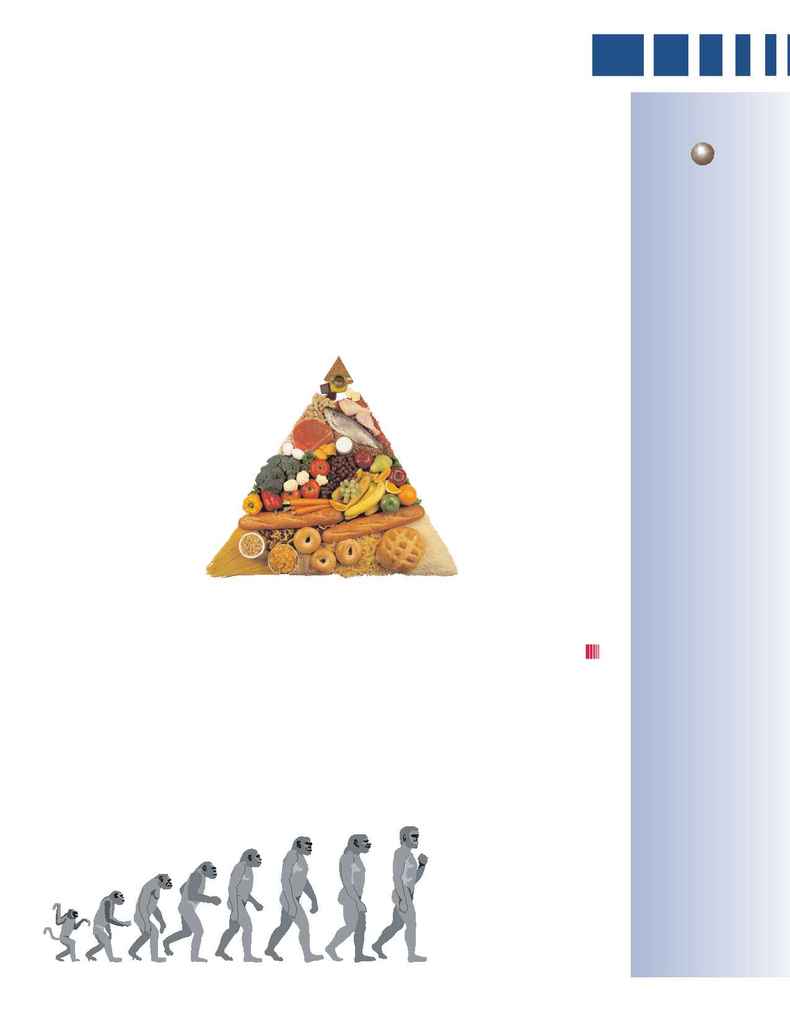
significant changes in man's physiological structure to occur.) For
this reason, researchers believe that weight gain is the product of
an "ancient metabolism" operating within a changed environment
easy access to food and decreased energy expenditure. For exam-
ple, in order for today's population to consume a diet similar to
that of ancient man, consumers would need to increase their fruit
and vegetable consumption by 20-25 percent. Research suggests
that Americans eat about 15 grams of fiber daily. However, ancient
people, who were not primary meat eaters, probably consumed
100 to 150 grams a day.
Adopting this ancient diet today would also mean a reduced
consumption of meat, and a 15 percent to 30 percent reduction in
refined sugars and processed grains. This ancient diet uti-
lized 5-6 servings of whole-grains compared with the Food
Guide Pyramid's recommended 6-11 servings.
The sugars and fats found in today's foods are
quite different than those nutrients consumed so
long ago. Honey bears the closest ancient food
substance to a modern day candy bar but was
only available in certain geographic regions
and seasons. Dietitian Elizabeth Somer,
author of the "Origin Diet: How Eating
Like Our Stone Age Ancestors Will
Maximize Your Health" states, "The
age-old advice to eat a variety of
foods is actually based on habits
developed over several million
years and was the secret to our ultra-great-grandparents' evolution-
ary success. Their high quality diets were based on a wide array of
foods (up to 333 different species of plants, insects and small ani-
mals) and were richer in protein and high-calorie foods than diets
of previous generations."
In addition to the change in the type of food consumed, the
availability of food has also changed and may play a role in a per-
son's predisposition to obesity. For ancient man, periods of famine
and a lack of resources were common. The human metabolism
appears engineered for the survival advantages of storing energy/fat
when food is in abundance. This trait allowed ancient man to con-
tinue to thrive and reproduce during times of famine. Although
this adaptation lends itself to an increased chance of survival under
harsh living conditions, it may be "encouraging"
the storage of fat today a time when famine is
not an issue for most. Dr. Eaton has noted,
"Today our bodies and lives are out of step with
each other. We have genes that quite literally
belong to the Stone Age. But we have drastically
altered the way we live and our biology hasn't
had a chance to catch up. We're living longer
than our ancestors, but we're dying from dis-
eases they never knew."
But it's not just a shift in eating habits and
access to food that has changed. Activity levels
have changed, too. A typical day for our ancient
ancestors included large energy expenditures
just to survive. Their caloric expenditure likely
ranged from 1,600 2,000 calories daily.
Experts estimate that the hunter-gatherer
expenditure is four times higher than that
of modern man.
Some scientists believe that the
changes in diet, easier access to food
and decreased activity levels are
responsible for the increasing
prevalence of overweight and
obese individuals in mod-
ern populations. Although
this is just one theory,
perhaps there is something that can be learned
from our ancient ancestors so that today's popu-
lation can continue to flourish and become a
healthier, more active population.
References
Eaton, S. B., Shostak, M., and Konner, M. (1988). The Paleolithic
Prescription: A Program of Diet and Exercise and a Design for
Living. New York: Harper and Row.
Lev-Ran, Arye. Human Obesity: An Evolutionary Approach to
Understanding Our Bulging Waistline. Diabetes Metab. Res. Rev.
2001; 17:347-362.
Nutrition Lessons from the Stone Age: Clues to Better Eating Go
Back 40,000 years.
Tufts University Health & Nutrition Letter. May 1, 2001. No. 3,
Vol. 19; Pg. 4
Smith, E.O. (2002). When Culture and Biology
Collide. New Jersey: Rutgers University Press.
Somer, Elizabeth, The Origin Diet: How Eating
Like Our Stone Age Ancestors Will Maximize
Your Health. Henry Holt & Company, 2001.
9
"The age-old
advice to eat a
variety of foods
is actually based
on habits
developed over
several million
years and was
the secret to our
ultra-great-
grandparents'
evolutionary
success. Their
high quality diets
were based on a
wide array of
foods (up to 333
different species
of plants, insects
and small
animals) and
were richer in
protein and
high-calorie
foods than diets
of previous
generations."
-- Elizabeth
Somer,
AUTHOR OF
"O
RIGIN
D
IET
: H
OW
E
ATING
L
IKE
O
UR
S
TONE
A
GE
A
NCESTORS WILL
M
AXIMIZE
Y
OUR
H
EALTH
"
Cave Man Cuisine
(continued from page 8)
